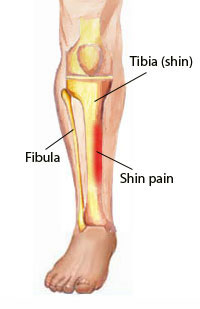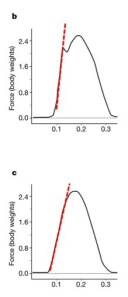Shin splints (or Medial Tibial Stress Syndrome, or ‘MTSS’) is one of the most common injuries seen in runners. It can affect both new and experienced runners, but is most commonly seen in novices.
Shin splints has been poorly understood over the years and a great deal of common misconceptions exist regarding its aetiology (cause). The most commonly held myth, (probably based on old scientific ideas) is that its is caused by muscles of the lower leg tearing at the place where they attach to the tibia (shin bone). Newer studies have shown that shin splints is in fact an injury to the bone itself (see references here , here and here). It is most accurately described as a ‘boney overload’ injury. Normally the stress of running results in micro-damage to the bone, and stimulates an adaptation process to strengthen it. When this damage exceeds the bodies ability to produce new bone, localized areas of osteopenia (reduced bone density) result.

So, when we consider shin splints vs. stress fractures of the tibia, they are essentially the same injury along a spectrum of increasing severity. MTSS usually involves localized areas of osteopenia and bone growth activity, a “stress reaction” is a bit worse and it’s when the bone marrow begins to have edema (swelling) and then fat the other end of the spectrum you get a stress fracture where there are actual fracture lines present in the cortex of the bone as seen on the MRI/CT. MTSS, bone stress reaction and stress fracture are different stages of the same cause – overloading of the tibia with an inability of the bone repair to keep up with the stress applied to it. So the million dollar question now is…how do we treat shin splints?
Treatment of the condition requires 2 approaches: 1) Reduce stress to the tibia and 2) Increase bone strength
1) Reducing stress on the tibia is easy
Running technique is a key factor in shin splints
Loading is synonymous with force. Research suggests that something called “loading rate” (or “vertical loading rate”, or “VLR”) is associated with certain injuries. The “rate” of loading refers to how fast the load is applied. The video here (watch video 3) demonstrates ground reaction force or how much force is being applied upon impact. VLR is demonstrated by the steepness of the force curve. For this runner who is impacting the ground heel-first, there is an initial steep increase in force, and then a second peak and they roll from heel to toe.
 VLR is also shown on the graphs to the side. If the slope of the curve is steep, that means you are applying a load under a shorter period of time (i.e more quickly) which is a higher “rate” of loading.
VLR is also shown on the graphs to the side. If the slope of the curve is steep, that means you are applying a load under a shorter period of time (i.e more quickly) which is a higher “rate” of loading.
So, how does this relate to shin splints? Well, several studies have found VLR to be related to injury risk. Irene Davis did a prospective study (here) where they followed 242 runners for 2 years. Over the 2 years, 57% of them sustained an injury including iliotibial band syndrome, anterior knee pain, Shin splints and plantar fasciitis. Statistically significant differences included average vertical loading rate and tibial shock values. They stated, “Based upon the odds ratio for VALR (vertical average loading rate), reducing impacts is likely to result in an overall reduction of injury risk.”
Several studies have specifically shown that loading rate is associated with injuries to the shin (here, here and here).
How do we alter a runners loading rate?…you guessed it, running technique! Loading rate can be significantly reduced by making changes to a runners gait. This is what i witness every week in clinic working runners with shin splints. In the clinic i use video analysis – this consistently shows certain technique characteristics in runners with shin splints (these are consistent with a high VLR), and modifying these with drills (and strength work- see the next section) provides AMAZING outcomes.
lower leg strength is important
This is a factor that has been shown to correlate to MTSS in a few different studies. It has been correlated with increased tibial stress fractures here, smaller calf girth has been correlated to MTSS here, poor calf muscle endurance has been correlated to MTSS here , and it’s likely because the calf muscles can absorb the shock of landing better than the bone – here. So, starting a calf muscle strengthening program would probably be a good idea in most people suffering from MTSS.
“Over” pronation probably isn’t important
‘Overpronation’ has historically been a popular topic when it comes to shin splints. This has been a term that is thrown around without much thought. Unfortunately, we can’t even agree on what “normal” pronation is, and if we can’t figure out what normal is, how do we know what “overpronation is? There are a couple of great blog posts on the myth of overpronation here and here. Studies on whether or not “over”pronation has anything at all to do with MTSS are mixed.
Most of the studies linking excessive pronation with MTSS are researched by using subjects who are already suffering from MTSS. The problem with that research method is that you don’t know if they are “over”pronating because they are already injured or if the “over”pronation caused the injury (i.e. is it a cause or effect).
I tend to not use the words ‘over-pronation’ in clinic anymore as i don’t find them useful. Instead, if a client displays lots of pronation i would note that they ‘have lots of pronation’. I’m not judging this to be a good or a bad thing. Some studies have actually found larger amounts of pronation to be protective against injury. I will however. want to see WHY they move this way. There can be lots of factors (often in combination) that influence the overall amount of pronation a runner has and also the timing (probably more important) of that pronation. Two significant pronation-affecting factors include ankle/ calf flexibility and motor control of the hip.The hip, as the more proximal joint (closer to the trunk), has far-greater influence over the ankle, than the ankle has over the hip (and the rest of the leg!). This is why whole body gait analysis is so important when assessing runners- just looking at somebody’s ankles tells you very little.
Even when a runner demonstrates lots of pronation, this will be modifiable by strength, flexibility and running technique changes.
To summarise i’d say: Running technique and appropriate conditioning are key to shin splints, meaning it should be relatively easy to treat.
2) Increasing bone strength takes a little longer
Gradually Increase Mileage
When a bone undergoes some stress, it needs time to build back up. Studies show that after you start increasing stress to a bone, it takes about 30-45 days to get building up it’s strength. That means that when you initially start a running program, there is a period of 1-2 months where the bone is being broken down by the stress and it hasn’t had time to build itself back up yet (seehere]. That is a significant amount of time when the bone is MORE vulnerable to injury. Therefore we need to take a very slow approach to training. This is why new runners are more prone to shin splints, and also runners returning after an injury. It takes a couple of months of running to slowly build up bone strength.
Manage Your Pace
Loading rate increases with increasing pace. Begin with slower running until your bones have built enough strength to add in speed work or tempo runs. You can read more about training slower and building a proper aerobic base here
Test the Health of Your Bones
For runners with recurrent MTSS, it can be worth seeing a Dr to test bone density and various blood measures that affect bone health. There are many factors that could find out why you are vulnerable to bone injury.
For the clinicians
Good subjective and Objective examination is vital- remember ‘shin splints’ can be caused by numerous underlying pathologies and is occasionally a very serious condition (e.g. compartment syndrome). Look for risk factors in each individual- although shin splints should in theory be a simple condition to treat, every individual case is different. Thorough examination is vital for getting each patient to recover fully and as quickly as possible.
Running technique plays a huge part in shin splints. Find a Physio or running technique coach who is experienced at biomechanical analysis and gait re-education. Get them to analyse the client’s gait for risk factors.
I often don’t make any changes to footwear, unless i feel the clients shoes are negatively affecting their technique- in particular by increasing VLR, over striding, slowing down cadence etc. Where i do change shoes in shin-splints patients this is most often for lighter, LESS cushioned shoes which tend to encourage a lighter landing and quicker cadence (directly addressing major risk factors for the condition). Monitor how they respond to different shoes. Some clients quickly make positive technique changes with minor shoe changes, whilst others need to go much more minimalist before they respond. Avoid the temptation to increase structure or cushioning, this can often exacerbate the underlying causes of the condition and is not something that i recommend for shin splints (or knee pain in runners- a post on this will follow).
